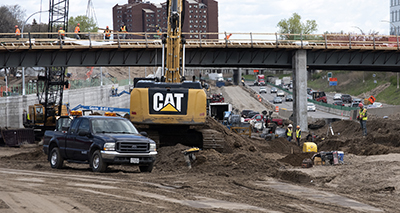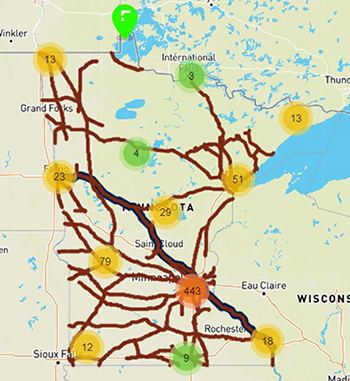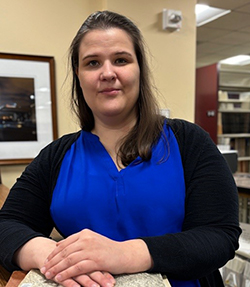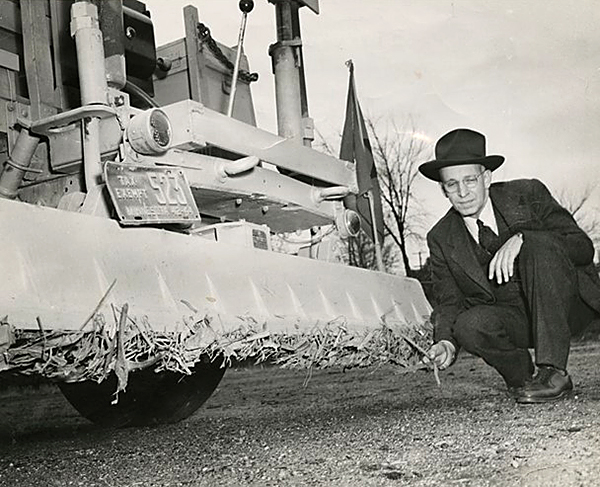 |
|

|

| TABLE of CONTENTS
 |
MnDOT surpasses DBE participation goal |
By Su Love, Office of Civil Rights

The 35W@94: Downtown to Crosstown project, shown here during construction in 2019, had more than 15% DBE participation. Photo by Rich Kemp |
MnDOT surpassed its Disadvantaged Business Enterprise participation goal on Federal Highway Administration-funded contracts in federal fiscal year 2023, marking the first time that MnDOT has met or exceeded this goal.
The DBE participation goal for FHWA-funded projects in 2023 was 12.6%. This goal is calculated by determining what percentage of FHWA-funded contracts, awarded during Federal Fiscal Year 2023, were committed to certified DBE firms. MnDOT not only met its annual goal but exceeded it, with 14.1% participation in Federal Fiscal Year 2023.
MnDOT’s DBE program is designed to level the playing field for women- and BIPOC-owned businesses, to remedy ongoing discrimination and the continuing effects of past discrimination. The DBE program is mandated by the U.S. Dept. of Transportation and authorized by Congress. DBE firms are for-profit small businesses that are at least 51% owned and managed by socially and economically disadvantaged individuals.
“Having a DBE program has been instrumental in helping women get into the industry and prove that we belong here,” LouAnne Loewen, CEO of J&L Steel Erectors and J&L Jobsite Solutions said. Because of the DBE program, “prime contractors are always looking for ready, willing and able subcontractors to help them reach the DBE goals on their projects. It’s not a ‘get rich quick’ opportunity. You have to work hard and perform to the end of the project. You must earn the respect of your contractor.”

DBE participation on FHWA-funded projects has increased significantly since 2012. Chart provided by Office of Civil Rights |
Achieving this goal is part of MnDOT’s strategic plan and is the result of years of work advancing equity in transportation. MnDOT’s Civil Rights programs have supported this work through certification, compliance and business development. This achievement also reflects the support of agency leadership, numerous other departments, MnDOT District Offices, and the prime contractors who subcontract with these businesses. Most important, this would not be possible without the disadvantaged businesses themselves who perform this work to achieve a safe, accessible, efficient and reliable multimodal transportation system throughout the state.
MnDOT’s DBE participation in 2023 represents a high point for the agency and reflects an upward trend in DBE participation on these contracts since 2012. In 2012, DBE participation on these contracts was 6.6% compared with 14.1% in Federal Fiscal Year 2023 – an overall increase of 114%. In actual dollars, this means more than $129 million went to certified DBE firms in Federal Fiscal Year 2023.
The methodology for setting DBE goals considers availability of qualified firms and their location, firm size, credit risk and other characteristics of DBE versus non-DBE contracts. MnDOT’s Office of Civil Rights contracts with the Center for Transportation Studies at the University of Minnesota for a factual foundation for this purpose. The Office of Civil Rights proposes a goal and receives public comment. After considering public comment, the final proposal is sent to the FHWA and FTA for approval. Once approved, these goals are used as a condition of receiving federal funds and as a performance measure of MnDOT’s DBE program.
MnDOT meets its overall DBE program goal through DBE participation on individual projects, which themselves may have a specific DBE participation goal. The DBE participation goal is a percentage of the contract that is targeted for certified DBE firms to perform on the project.
The Office of Civil Rights evaluates construction projects and professional technical proposals for participation goals on federally funded MnDOT projects or contracts before the project is advertised. The DBE participation goal considers the location, scopes of work to be performed and availability of DBE firms.
To be awarded a contract with a DBE participation goal, the apparent low bidder or selected responder must meet the DBE participation goal or demonstrate adequate good faith efforts to meet the goal. Apparent low bidders can get credit toward DBE goals by subcontracting work to DBEs, purchasing supplies from DBEs, and other methods detailed in the DBE Special Provisions (PDF).
Not all projects are required to have DBE goals. Smaller projects that are federally funded may not have a DBE participation goal and are considered race/gender-neutral contracts. The Office of Civil rights monitors these contracts for DBE participation as well.
MnDOT’s agency goal is set for a three-year period, so the goals for federal fiscal year 2024 remains 12.6% for projects funded by FHWA and 6.8% of projects funded by FTA. The Office of Civil Rights is currently working with the University of Minnesota on the new goals for 2025-2027.
For more about for DBE participation increase since 2012, visit the Performance Measures page on the MnDOT website.
Thanks to Sean Skibbie and Adrienne Bond for their contributions to this article. |
| |
|

|
 |
TABLE of CONTENTS
 |
Let's Talk Transportation continues to grow as public engagement tool |
By Kayla Dean, Office of Communications and Public Engagement

Letís Talk Transportation features many public engagement functions, including interactive maps like this one used for the State Rail Plan. Provided graphic |
Let’s Talk Transportation, MnDOT’s newest online public engagement platform, has entered its third year of use for two-way engagement through features including surveys, mapping tools, news feed and a Q&A section. Since the launching the platform, MnDOT has continued to add more projects, with 54 currently on the platform, up from 27 last year.
As the agency continues to expand its use of Let’s Talk Transportation, public engagement staff encourage employees to learn more about the platform and how it works.
A brief overview:
The goal of Let’s Talk Transportation is to eliminate microsites and to build a central repository for tracking, documenting and retrieving public comment data and suggestions. In addition, the platform acts as a one-stop shop for all things engagement. MnDOT users can track traffic sources, data and reporting in real time, and many report finding the platform easy to use when working on the backend. Let’s Talk Transportation can be used alongside other engagement methods, as MnDOT public engagement staff seek to be flexible, adaptive approaches to address the anticipated impacts that a project may have on community members in the affected area — the platform is one part of the practitioner’s toolbox.
The platform is hosted by Granicus and is used by other state agencies, including the Dept. of Human Services, the Dept. of Natural Resources and the Dept. of Correction, as well as many cities and counties.
Let’s Talk Transportation is online, making it easier for Minnesotans to provide input at their convenience. All projects are connected to a GovDelivery email topic code, which makes it easier for participants to sign up and stay connected. In addition, project admins can set up a link tree and a schedule; they can also use Let’s Talk Transportation to let respondents know when upcoming engagement activities will occur. The platform also has built-in 24/7 monitoring to weed out inflammatory comments.
Mike Foley and Kayla Dean of the Office of Communications and Public Engagement act as the site administrators. They serve a variety of needs, including meeting and explaining the setup and process to new and current users. In addition, they create, edit and review project pages before they go live to ensure that pages meet and follow Let’s Talk Transportation standards and guidance.
If you have a project, plan, or program that would lend itself well to the platform either for an upcoming construction project/study this year or for a future project, please contact Kayla Dean or visit the Public Engagement iHUB page. From there, you’ll be able to learn about support, best practices, the project life cycle and new learnings that are actively being updated. |
| |
|

|
 |
TABLE of CONTENTS
 |
Reminder: Pretax account reimbursement requests for 2023 due on Feb. 29 |
| By Robin Jordan, Human Resources
Employees who set aside money in pretax expense accounts for dependent care (daycare), medical/dental, or transit have until Feb. 29 to send in complete reimbursement requests for 2023 expenses. Some additional details about the different types of accounts:
- Dependent Care Expense Account (DCEA) is use it or lose it. You will lose any 2023 funds you didn’t submit eligible receipts for by Feb. 29, 2024.
- Medical Dental Expense Accounts (MDEA) may allow you to carry over up to $610 if you meet certain requirements. You will lose any amount over $610 if you don’t submit eligible receipts by Feb. 29, 2024.
- Transit Expense Accounts are Parking (PKEA) and Bus pass/Vanpool (BVEA). The deadline to submit eligible 2023 receipts is Feb. 29.
Check your account balance(s) on the Benefit Resource website. BRI also has detailed information about submitting reimbursement requests, required documentation, and carryover requirements.
Help is available from 7 a.m. to 7 p.m., Monday through Friday, using the following methods:
|
| |
|

|
 |
TABLE of CONTENTS
 |
Reminder: Auto-deletion process for files in Downloads folder begins March 6 |
| By Jeremy DePew, MNIT
Minnesota IT Services (MNIT) is implementing an auto-delete process for files in employees’ Downloads folder. This process will become effective March 6, 2024, for all state employees.
Any file in an employee’s Downloads folder that hasn’t been opened for at least 30 days will be automatically deleted. This new process will improve our data security and free up computer memory space.
The Downloads folder is never backed up, so once files are deleted, they cannot be recovered.
About the change
This automatic deletion process takes effect March 6, and will be ongoing for any files that are downloaded.
This will keep workstations in good functional order, clean up systems, free up valuable storage space and remove security vulnerabilities from workstations.
The automatic deletion process requires a change to the way you use your Downloads folder. The Downloads folder is intended as a temporary location for downloading files. It is not a secure storage method. Downloaded files that are intended for future use should be saved by moving them to a secure location.
What you need to do
- Act now: If you have files in your Downloads folder that you want to retain for future reference, move them immediately to your shared OneDrive or another secure location.
- Going forward: Create a new habit to manage your downloads. After downloading a file to your Downloads folder:
- If you want to save the file, immediately move it to a secure location for retention.
- If you don’t want the file, delete it, or move it to the Recycle Bin on your desktop.
- If you leave a file in your Downloads folder, it will be deleted if you have not opened it for 30 days.
- Learn more: For more information and FAQs, visit the MNIT Connect Extranet.
Options for saving files
- If you have files in your Downloads folder that you need to keep, move them to an approved storage place.
- Storage options include SharePoint, OneDrive, shared drives for your team, and the Documents folder on your computer.
- If you don’t know the approved storage location, please ask your supervisor or manager.
- To move files from your Downloads folder:
- Select the folder icon in the taskbar at the bottom of your computer screen to open the Explorer window.
- Under This PC in the left navigation menu, select the Downloads folder.
- Select the file you want to save and either “drag and drop” it to a new secure location, or right click on the file and choose an option from the drop-down menu.
Deletion process
Effective March 6, 2024, any files remaining in your Downloads folder that have not been opened for 30 days or longer will be deleted automatically.
You do not need to take any actions for the new file deletion process to be in effect on your computer.
Why this is important
- Files stored in the Downloads folder create potential security and data management risks.
- This process will reduce those risks from your device.
- This process will free up valuable memory space on state devices.
Questions or support for technical issues
Review the FAQs on MNIT Connect Extranet. If you have additional questions or concerns, please contact your manager or supervisor or the Legal Counsel at your organization. |
| |
|

|
 |
TABLE of CONTENTS
 |
On the Job: Madeline Kuncio does the research (and more) |

Madeline Kuncio |
By Doug Mack
From historic maps to obscure documents to the latest news in specific industries, there’s lots of information that MnDOT employees need but sometimes can’t find on their own. Madeline Kuncio and her colleagues at the MnDOT Library are there to help through research and other services.
How long have you been at MnDOT?
I started in August 2021, so about two and a half years.
Give us a quick overview of the library and the services you offer. How do people access it?
Most people think of us as a provider of books and e-books, but the bulk of the librarian’s work is reference and research for the entire agency, both in person and online. Most people reach out to us over email or our Ask-A-Librarian form, but we’re open every day from 8 a.m. to 4:30 p.m. We also send out curated news alerts on various topics of interest to MnDOT, like Connected and Automatous Vehicles, Sustainability and Public Health, and Government Workforce Development. Last year, we started the MnDOT Digital Library, which contains digitized copies of MnDOT material, including books, maps, photographs and reports.
What are your personal day-to-day tasks?
It depends on if I am at home or in the office. I come in at least once a week, and usually more. About half my time is spent working on the MnDOT Digital Library: getting materials scanned, creating metadata and ingesting the items into the library. If I’m in the office, I work on projects such as preparing material for digitization, working with the physical collection and doing research that I can’t do online. If I’m at home, I focus on uploading documents to the digital library and creating metadata, and anything I can do completely electronically.
How does your job fit into the broader work of MnDOT?
We work with other offices when they need information and help accessing resources. MnDOT Library is a focused, specialized library, so for materials requested by staff that we don’t own, I borrow reports, books and articles from other libraries, who borrow specialized material from us as well. Now that we have the MnDOT Digital Library, I work with other offices to see if they have material that they want to preserve in another repository. The material we collect sometimes overlaps with eDOCs, but it has both a wider and narrower focus.
What the most challenging and rewarding parts of your job?
The most rewarding part is being able to dig into a topic and learn new information that changes how I think about things in my life. For example, I recently did research on snowplows, and I learned a lot about how plows work. I’ve lived in Minnesota my entire life, but I’ve never thought about plows in any detail. The most challenging part is related to that. Sometimes I can’t find the information the customer needs, and I don’t know if it doesn’t exist or if there is an error in my search technique.
Is there anything about your job that might surprise other people (either inside or outside MnDOT)?
Probably how many different subjects my work touches on. I’ve done research on Minnesota laws, public engagement best practices, the history of the Office of Communications and how DOTs around the country are planting native plant species to make roadsides into pollinator habitats.
What are your interests or hobbies outside your work with MnDOT?
I love to cook, and I’m trying to learn painting at the moment.
Do you or a co-worker have an interesting job to share with readers? Send us your ideas, and we’ll contact you for more information.
Recent employee profiles:
|
| |
|

|
 |
TABLE of CONTENTS
 |
SWAT and FUEL to host Disability Inclusion Awareness Training session on March 6 |
By Doug Mack
The Strategic Women Advancing Transportation (SWAT) and Fully Utilizing Employees without Labeling (FUEL) Employee Resource Groups invite all MnDOT employees to join a Disability Inclusion Awareness Training Lunch and Learn on March 6 from noon to 1 p.m.
The event is designed for recruiting, hiring and managing employees and workgroups interested in increasing their diversity inclusion knowledge and skills. The session is a safe place to learn and talk about disability topics, including:
- Disability statistics, myths, etiquette, historical perspectives and communication tips
- The Americans with Disabilities Act (ADA) and how a disability is defined
- Practical steps for complying with ADA, supporting disability disclosure and providing reasonable accommodations
If you have any questions about the March 6 event, please contact Chris Ward.
Join the March 6 Lunch and Learn on Teams.
Closed captioning is available for this event. To learn more about Employee Resource Groups, visit the ERG page on iHUB or contact Frida Alvarez.
|
| |
|

|
 |
TABLE of CONTENTS
 |
Transportation History Highlight |
By Micaela Kranz, Office of Research & Innovation

An employee of the Minnesota Dept. of Highways shows off a road magnet, which moves stray bits of metal from the roads, in 1948. Photo from the Minnesota Digital Library |
|
| |
|

|
 |
TABLE of CONTENTS
|
Name That Place Puzzler #20 |
By Doug Mack
Can you name the place pictured below? If you think you know the answer, email Newsline editor Doug Mack. The first three people to submit the correct answer will receive the fame and glory of having their names listed in the next issue of Newsline.
Answer to the last Puzzler: I-694 near Valentine Lake (because the issue came out on Valentine’s Day). The first people to get it right were Tristan Karls (Bridge Design Section), Patrick Gilbertson (Office of Land Management), Dave Larson (Office of Materials and Research) and Joseph Mandelko (Office of Land Management). Congrats to them and thanks to everyone who played!
|
 |
|
|
|



